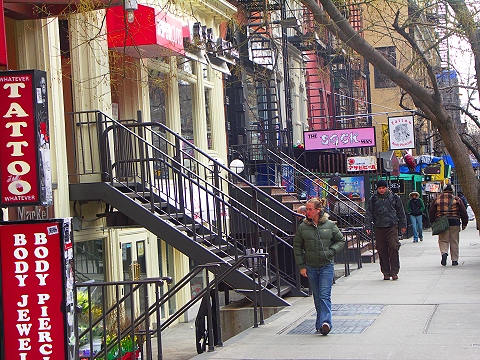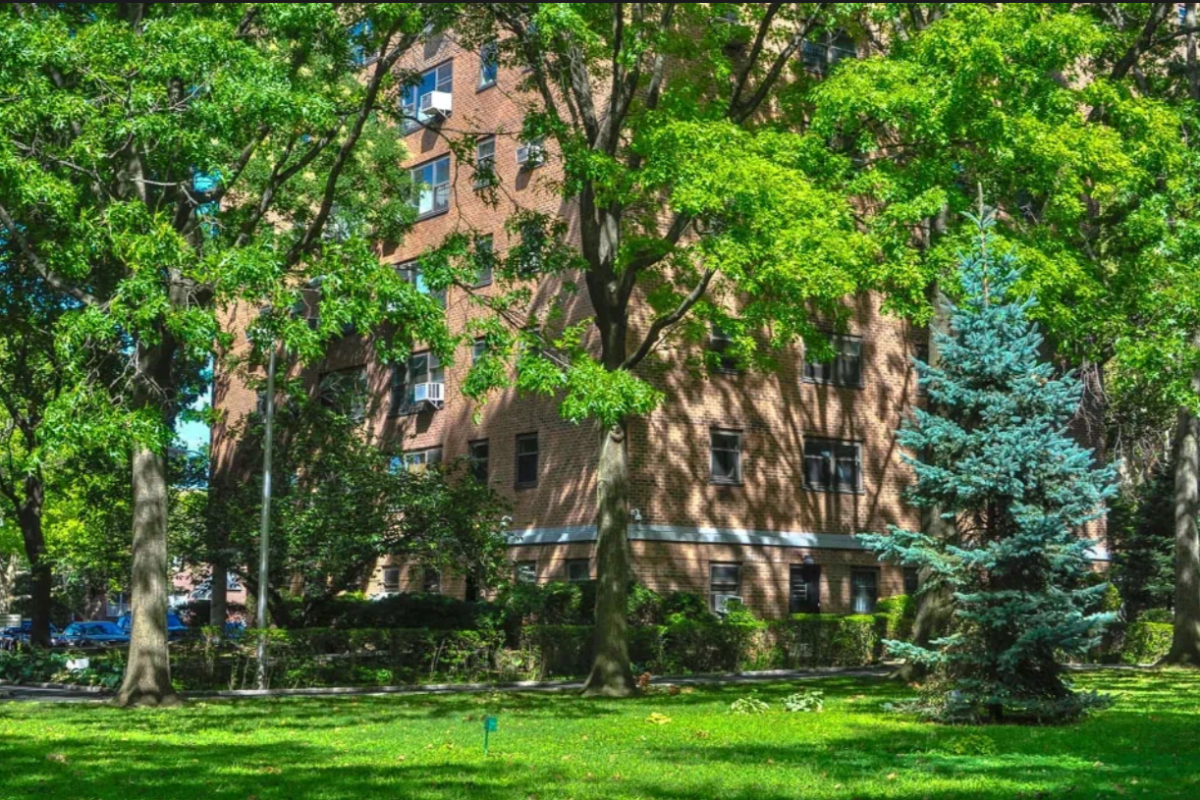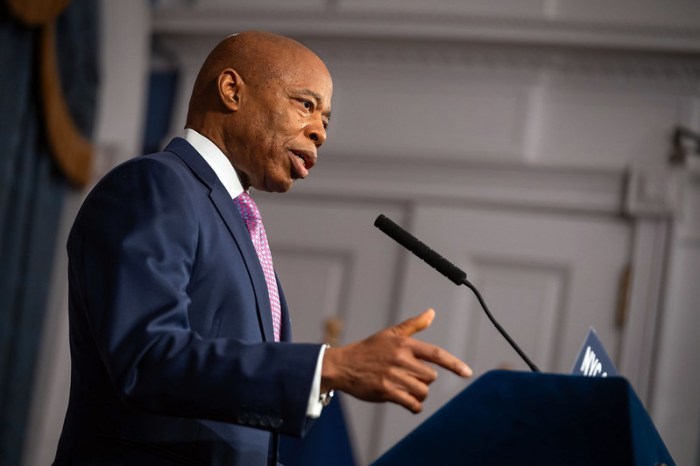BY BILL WEINBERG | After more than a generation of living on E. Fourth St. in the East Village, I feel more and more like I’m in the old joke about the city slicker who asks the farmer for directions on a country road. Punch line: the farmer says, “Oh yeah, you make a left where the old red barn used to be.” The irony is that this native New Yorker “is” the old farmer in the joke.
This past month, I was hit with a triple whammy. Three longtime businesses that had been there as long as I could remember closed their doors for the last time. The 2nd Ave Launderette, where I’d been washing my clothes for years, run by very sweet Puerto Rican folks, was forced to close by rising rents. Ditto the check-cashing place on 14 St. where I’d been paying my utility bills for years.
Yet, somehow it’s the place I frequented the least that hits me the hardest.
Plantworks had been on my block for 40 years… . It stuck it out through the rough desolate years of the late 1970s and ’80s, when this stretch of the East Village was still called The Bowery and considered a “bad neighborhood,” before it became gentrified “Noho.” Now Plantworks is also being forced out.
I hadn’t actually bought anything there since I procured my indestructible mascot, a golden pothos I call Arnold, some 15 years ago. But the owner was a familiar face, who I’d passed almost every day for a sizeable chunk of my life. I finally learned his name when I spoke to him for this column, approaching him as he stood outside his now near-empty storefront, on the final days of a clearance sale.
His name is Chris Baptiste, and he came from Trinidad to open Plantworks back in the 1970s. It had been at its current location on E. Fourth St. between Bowery and Lafayette St. for 30 years, and was at another location on Waverly Place for some 10 before that. He had hoped to find a third location and stay in business, but is starting to despair of this.
“We cannot get a space,” Baptiste told me. “Banks and Wall Street and CVS and Duane Reade — they are the only ones who can survive.”
Baptiste said the building, which is now a co-op, had tripled the rent on his storefront to $15,000 a few years ago. (It had been a mere $3,000 when he opened.) It is now being jacked up to $40,000 — more than he can afford. With no lease, he has no recourse.
“I’m 74,” said Baptiste, obviously struggling for some optimism. “I can still work. I’d like to continue working. One door closes and another opens.” But he admitted: “Small businesses are in big trouble in Manhattan. Manhattan is becoming a place to come and work and then go home to the Bronx or Brooklyn. It’s just for the rich and the tourists.”
And Plantworks is to be replaced, Baptiste says, by yet another gym. There is already a gym right around the corner on Cooper Square West, in the new luxury development that went up a few years ago…and another one around the other corner, up Lafayette St….and yet another one where Tower Records used to be, directly across Lafayette. And another one two blocks to the east, on E. Fourth St. near Second Ave. Is the market really not saturated yet? I find myself wondering: How many narcissistic yuppie masochists can there be in Noho?
But what hits closer to home still is the news, reported in the New York Post last week, that the former Yippie Cafe, over on Bleecker St., is to be replaced by a boxing gym. The cafe had been closed for several months, as creditors repossessed the building and evicted Yippie Holdings — a surviving fragment of the Yippie radical youth movement of the 1960s. I spent much of my own youth among the latter-day Yips at the notoriously malodorous hangout that we called “Number 9” back in the early ’80s. This was the most gutting line in the Post story: “The new gym will be called Overthrow NYC — a reference to one of the alternative newspapers the Yippies published from Number 9.”
Overthrow is where I cut my teeth as a journalist. The first reporting I ever did — on the anti-nuclear movement, Native American resistance to mining schemes, revolutionary struggles in Central America — was for the radical rag published on the third floor of Number 9. Now the name is to be appropriated by a joint catering to yuppie narcissists with some kind of prole pretensions — the kind who would patronize a boxing gym?
O.K., I hadn’t gone into Number 9 very much since it was resurrected as the Yippie Cafe a few years ago — I found some of the personalities that hung out there to be deeply annoying. But I still felt a pang at its demise. For me, it was rather like that of Junior’s cheesecake emporium on Brooklyn’s Flatbush Ave. I hadn’t gone into the joint in years, viewing cheesecake as a decadent indulgence. But its closure still hurt, as a landmark I had known all my life disappeared from the cityscape. With Number 9, it felt like a part of my past was being erased.
It was with this despairing attitude that I dropped by the former Number 9, to speak with Joey Goodwin, the young entrepreneur behind the new “Overthrow” boxing gym. I found him to be a likeable and straightforward kind of guy.
“I found the [Overthrow] magazines covered in cat piss,” he told me. “The name is powerful and has a history behind it.”
Goodwin said he grew up in Florida but has been living at various locations around Downtown Manhattan for much of his life, and was long a fixture playing basketball at the court on Sixth Ave. and W. Fourth St. He admits he expects a “white-collar clientele,” and that’s “not the answer the Yippies want to hear.” He insisted, almost apologetically, that he is very “liberal” — not seeming to get that, for the anarchist Yippies, this was a term of opprobrium. He tells me he bought a copy of Abbie Hoffman’s “Steal This Book” to get up to speed on the Yippie ethos. To my relief, he said he intends to erect some kind of marker or exhibit on the premises explaining the name and the building’s counterculture history.
But he also admitted that he sees “John Varvatos as a model” — the fashion boutique in the site of the old CBGB, which is self-consciously cashing in on the rock ’n’ roll image and mystique.
A particular sinister characteristic of post-modern or “too late” capitalism is its relentless displacement of organic social realities with the pre-packaged oxymoron of pseudo-authenticity — as when Starbucks pushes out Greenwich Village coffee shops, or the Subway chain pushes out authentic New York sandwich joints. This is an appropriation and privatization of what Walter Benjamin identified as the “trace” of authenticity — the false promise that entices us into complicity in the destruction of our own culture. Or, as Jean Baudrillard observed: “Everything is replaced by its own simulacrum.”
There are some other obvious and very irritating examples. The upscale DBGB bar and grill in the new luxury development a block down from the former CBGB site is also shamelessly exploiting the legacy of the legendary, defunct rock club.
There are still more depressing examples elsewhere on the Lower East Side. The Eastville Gardens housing development on E. Seventh St. is thusly named because it is on the former site of the beautiful Esperanza Garden — which was bulldozed in February 2000 to make way for the housing development! Or the interior concrete courtyard in the shape of a Tao symbol at the housing project on Eldridge St. — where the heart of old Adam Purple’s Tao-shaped Garden of Eden used to be before it was destroyed to make way for the housing project in 1986.
These are fast becoming meaningless symbols, as their origins fade from memory. I try to tell myself this is a natural process that has been going on in New York City since the beginning. After all, the Bowery itself is named for the Dutch word for farm — because it cut through what was the sprawling estate of Peter Stuyvesant. Who remembers that today other than history buffs? Or that Clinton St. (as well the new moniker for what used to be Hell’s Kitchen) is named for DeWitt Clinton, New York state’s early and influential governor? Or that Morrisania in the Bronx is named for the aristocratic Revolutionary War hero Gouverneur Morris? But these examples reveal more of an organic process rather than conscious acts of cultural appropriation.
A bitter irony of this process is that the hipsters (who followed the Beats, punks and Yippies) made the Bowery/Noho and the L.E.S./East Village fashionable for the more upscale crowd that, in turn, followed them — and who are now making the enclave increasingly sterile and domesticated.
This process is also evident in the changing names of the business establishments. The once-fashionable Bowery Bar (which was an abandoned gas station when I moved onto the block) is today known simply as B-Bar, an admission that “The Bowery” is now déclassé — or that the clientele has changed from “slumming” edgy types to tourists and suburbanites. The slightly upscale Mexican joint a few doors down is called Hecho en DUMBO — a Manhattan business establishment named for a neighborhood in Brooklyn. This is an admission that the cutting edge of chic has long since jumped the East River. Another few doors down is the Deth Killers boutique (in the site of what was until recently an auto repair shop), which pitches its designer jeans as “Bushwick style.”
Us old-school hipsters who played our paradoxical role a generation ago in making the district fashionable have now become strangers in a strange land. Check-cashing places are closing because yuppies pay bills online, and paranoiacs like me who prefer to pay cash are apparently seen as doomed to extinction. As for laundromats — I’m really not sure where yuppies are supposed to wash their clothes, but they clearly don’t want to live in the same neighborhood with anything so quotidian and working-class as a laundromat.
Chris Baptiste recalled the old days as we chatted in front of his empty storefront.
“This block — it was bad,” he said. “There were crackheads, violence, theft, arson. If you left a bicycle on the block, the crackheads would take it around the corner to sell it.”
I remember those times, and they were certainly challenging. Romanticizing squalor is clearly perverse. But back then, when my building was on rent strike because the landlord wasn’t doing any upkeep, we had a tenants association. It was factionalized and dysfunctional, but it was capable of organizing an ultimately successful rent strike. (The city took over the building from the slumlord, ultimately flipping it to a new and more respectable landlord.)
Today, the notion of organizing the tenants in my building is unthinkable. They are mostly yups, who stay just a year or two, facilitating massive rent hikes with each new lease, and have contempt for the few rent-stabilized holdouts in the building, such as myself.
As to the bigger question of actually trying to organize the neighborhood to protect small businesses and fight back the tide of luxury development, one wonders if it’s still possible over to the east in Alphabet City. But I see few signs of potential here in “Noho.”
If anyone out there has any ideas, I’d like to hear ’em.


































